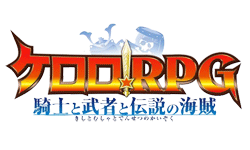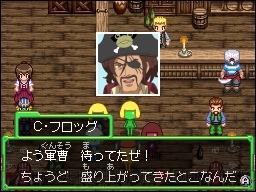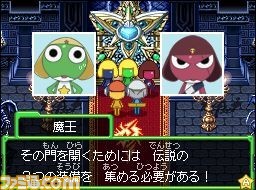|
|

|
PLATFORM
|
DS
|
BATTLE SYSTEM
|

|
INTERACTION
|

|
ORIGINALITY
|

|
STORY
|

|
MUSIC & SOUND
|

|
VISUALS
|

|
CHALLENGE
|
Adjustable
|
LANGUAGE BARRIER
|
Moderate
|
COMPLETION TIME
|
20 - 40 Hours
|
|
OVERALL

|
+ Large amount of side material.
+ Great sense of humor in the writing.
+ Prolific voice acting.
- Some prior knowledge of material recommended.
- Story is rather cliché.
|
Click here for scoring definitions
|
|
|
I'm not sure what I was expecting when I picked up Keroro RPG - The Knight, the Warrior, and the Legendary Pirate. I knew that it was developed by the Tales Studio, and that it had a bizarre list of in-game cameos from Bandai-Namco's past, but I still had no idea what I would think of a third-party licensed game. My past experience with such titles had left me a bit lukewarm on them.
Having finished the game, I can now say that it was one of the best titles I'll have played this year.
One cannot start any commentary on this game's plot without some reference to the manga or its characters. Keroro loves Gundam, Tamama has an insane alter-ego, Giroro is gruff and trigger happy, Kururu is creepy and tricky, and Dororo is equal parts ninja and milktoast. Anyone who has read the manga knows the basics about each of the main characters. Anyone who hasn't read it really should consider doing so before attempting this game, as various parts of the story won't make much sense (or be nearly as funny) without that context. Even a little time spent perusing the adventures of the Keroro Platoon is good preparation for this game -- and highly enjoyable to boot.
This reliance on prior knowledge of the characters is the weakest point of the story, and of the game overall. The plot itself is cliché-ridden as may be, but when played through the eyes of Keroro, who is well aware that he's in an RPG, every scenario gains an odd, meta twist to it. From the "hero" complaining how dull it is to actually trudge through a dungeon, to the occasional commentary on standard gameplay mechanics, to outright arguments between Keroro and the Narrator on points of definition, there's rarely a dull moment to be had between plot points.
 Star Warriors
Star Warriors
|
|
The best part of the story, and what helps twist everything slightly askew, is the character motivation. It all starts when Keroro boots up a rare and unusual video game, and monsters start pouring into "real-world" Tokyo. Instead of jumping into action to fix the mess he made, Keroro's motivation is to avoid the weeks of toilet-cleaning duty promised to him as punishment if he doesn't make things right. Later on this evolves into an attitude of "Like heck is anyone going to conquer the world before we have a chance to!"
Keroro RPG goes to great lengths to both pay homage and satirize games in its genre. Item descriptions spoof contemporary games and manga. The innkeeper in one town complains about adventurer riffraff -- and specifically names the six base adventurer classes from Dragon Quest IX in the process. Characters comment on how there will be a tool to solve a specific dungeon puzzle somewhere nearby "because that's how these things work."
Setting the scene, the musical accompaniment for this game is both top-notch and strongly reminescent of 16-bit RPGs in style. Some tunes are obviously adapted from the anime, others (some of the best) are original. To top things off, every major plot scene in the game is voice-acted, to an extent not seen in most PS2 titles, much less a DS game. Some of the funniest voiced scenes occur in the game's post-battle comments, as certain characters will sometimes start arguments with other characters as the EXP and gold are tallied.
 Sgt. Frog meets Cap'n Frog
Sgt. Frog meets Cap'n Frog
|
|
The game's graphics are helped by having the manga and anime to serve as models, but are also hampered some by this. Within the boundaries set by the source material, battle effects and animations stand out beautifully while field graphics are merely adequate for the task. Other areas of the game, especially the KeroCa! card battle mini-game, seem tacked on in terms of graphics.
Having said all this, battles and the battle system really stand out the most in this game. Battles in Keroro RPG sport the best graphics and music the game has to offer. The battle theme for the Little Sisters, the game's trio of bad-girl antagonists, is one of the best in the game.
Accompanying all the flash and bang is a battle system lifted directly from the early Tales games and adapted with considerable success to the demands of the series' style. The most significant change is the elimination of MP. Instead all attacks and special moves use up one to three points on a character's Command Counter (CC), which can be increased through leveling or equipment management. The front character is controlled by the player, who chooses attacks by pressing the D-Pad and B button in various combinations. The other characters are controlled by the game's decent (if overly cautious) AI within the parameters set by an attack paradigm, then customized by equipping specific directives.
 Pac Attack!
Pac Attack!
|
|
The Tales Studio was given an intellectual property with a fan base ranging from first-graders to college students, and to its credit the developers have produced a game playable by a majority of that fanbase while keeping said game equally enjoyable to all. To start with, there are four levels of difficulty -- though Maniac Mode is only available upon completion -- and the game's difficulty may be adjusted at any time. Battles have three settings: Manual, where the player fully controls the front character's movement; Automatic, which is just what it sounds like; and Semi-Auto, where the front character is fully controllable but will hurtle himself at the target monster on command. Even in Auto Mode the player has full control over item use, AI settings, and the summoning of support characters -- enough to keep elementary schoolers busy and give them the very real sense that they're helping Keroro win the day.
For the more advanced gamer, there are various sorts of sub-systems in place to keep one busy. One can fine-tune the AI controls or cook food if one can find the recipes and ingredients. The previously mentioned KeroCa! game apes the conventions of Pokémon. Performance in battle is rewarded with points that can be redeemed for high-level items. Even basic equipment provides material to think about, as rarely does a new piece of equipment provide upgrades across the board, meaning that there are times when difficult choices must be made. Some of the strongest weapons give the lowest CC bonus, while others sacrifice attack power for a chance to make more frequent attacks. The game's defensive equipment, the Guardians (aka Gundam models), come with various support skills whose merits must be weighed as well. Each of the characters also comes with his own set of Codenames, which change how he appears in the field, affect various stats, and can even change how people react to him in conversation.
All the details of the game's systems are helpfully logged in a guidebook provided by the game's Dark Lord himself, and the game text, though riddled with kanji, never fails to provide furigana notations to show how problematic symbols are pronounced.
 Ominous...
Ominous...
|
|
Keroro RPG comes out to a decent thirty hours or so in length, though that does not include time spent doing various minor side-quests, fighting in the Colisseum, or playing KeroCa! with various NPCs. If one is lucky enough with CCG purchases, or good enough with a search engine, the secret codebook found early in the game can provide a bit of diversion as well. Finally, the game's hideously difficult optional dungeon, the Mou Iya Gallery, opens up after the final boss has been defeated once. Simply enough, there's a lot to do in this game.
As I said at the beginning, I wasn't sure what I'd be getting in this title. Instead of a slap-dash game cashing in on the success of a series, I found what is possibly one of the best DS RPGs I've played in a long time. It's a shame it has practically zero chance of ever coming to America.
Review Archives
|









